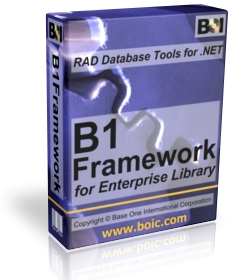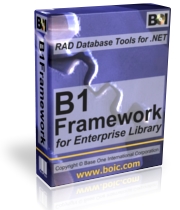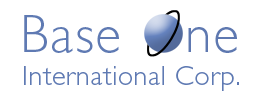
B1Framework (B1F) is a collection of reusable .NET components for
building web, back office, and desktop database applications. The
common data access layer and other core parts of B1F make it easier
to write high performance, database-agnostic programs, and they
provide a solid foundation for developing scalable commercial
services. Based on
Microsoft .NET Framework 4.0 and Enterprise Library 5.0 Application
Blocks, B1Framework adds indispensable components for database access, logging, validation, caching, exception
management, and security.
Data Access Layer
- The database access component presents a vendor neutral
interface for building and executing commands in the .Net
framework. It Illustrates how to use Enterprise Library's Data
Access Application Blocks in a database independent way
with SQL Server, Oracle, and DB2 databases.
- B1Framework's DataAccess namespace includes the standard functions for building and
executing database commands, and discovering or caching parameters; but it
also has classes for building compound SQL statements
that handle
automatic parameter creation, enabling multiple commands
to be
transmitted in a single database call.
- Compound commands can include calls to stored
procedures and parameterized dynamic SQL, and they can
include nested
transactions, reducing the need to hold resources between
calls to the database.
- Dynamic SQL and an in-memory cached database
catalog add powerful capabilities for automatically generating
Select, Insert, Delete, Merge commands that work against different databases.
B1Framework interfaces make it easier to write
high performance, multithreaded applications.
- The B1F Data Access layer includes a custom LINQ provider
that uses .NET expression trees for efficient processing of
complex joins, with C# compile-time error checking.
- The Paging class is a highly scalable means of querying
and scrolling though extremely large result sets efficiently, without
locking resources or resorting to full table scans and sorts. This
class includes an interface that works directly with
Entity Framework objects.
Database Setup
- B1Framework has a database setup utility for executing scripts to set up a new
database or alter an existing one. It employs back-end specific
command line tools that work with special DDL syntaxes and
allow all types of objects to be created.
- Includes examples showing how to use B1Framework to
perform multi-threaded, concurrent database operations
across different back-end databases with a common
code base.
Configuration
- The Configuration component has classes for accessing the
application settings, as well as supporting a concept of
runtime replacement
configuration parameters.
Security
- Hashing using MD5, SHA1, SHA256, SHA384, SHA512
- Symmetric encryption using DES, RC2, Rijndael, TripleDES.
- Asymmetric encryption using RSA & DSA.
- Digital envelope using asymmetric RSA for enveloping,
symmetric AES for encryption
- Digital signature using asymmetric RSA and DSA.
- Signing XML class using RSA
- Xml packaging using RSA for enveloping and signing, AES for
encypting and SHA1 for hashing
- Encrypted string with expiration timings
Application Logging
- Ability to log messages to multiple concurrent destinations
(such as Windows Event Log, database, memory file)
- Can be used with or without the configuration manager allowing
for both configurable and programmatic setup
- Support for the following targets:
- Windows Event Logger
- MSMQ Logger
- Memory File logger
- Standard file logging
- High performance Trace Logging (with a TraceViewer
windows application)
|
|
Get B1Framework for $29.95,
including full source code!

|
B1Framework is the next evolutionary step from the
Base One Foundation Component Library (BFC),
Base One's comprehensive suite of .NET tools built on a core
of legacy COM, MFC, and Visual C++ programming.
With over 15 years of continuous development and
refinement, BFC has a record of proven performance in large-scale
commercial applications. B1Framework takes BFC to the next level,
retooled in pure C# to gain maximum advantage from the latest .NET technologies.
|


